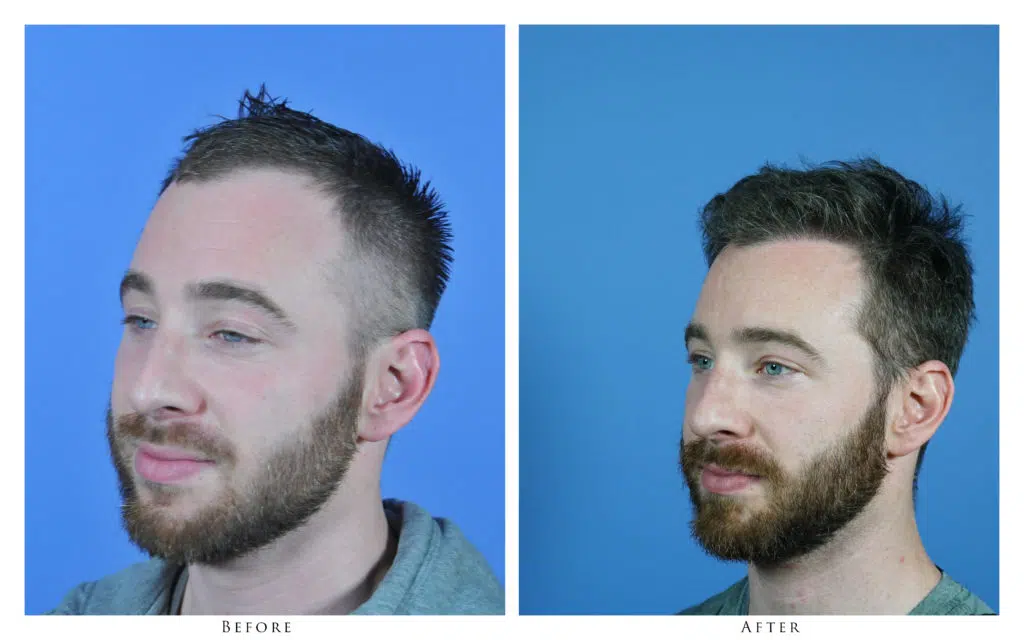
What is FUE?
Follicular Unit Excision (FUE) in Portland, OR is a method of excising or removing the donor hair for the purpose of hair transplantation and hair restoration. The donor’s hair usually is harvested in the back of the scalp where people have enough hair to donate those hairs to other parts of the scalp such as the frontal hairline, mid-scalp, or crown. In some instances, we will also use beard hair or body hair transplantation with chest hair as a source of the donor’s hair.
During the FUE hair transplant procedure, various instruments are used to extract the hairs from manual hand-held devices and electrical rotary instruments. Dr. Gabel uses a highly specialized device that was designed in Belgium which he feels is the best. He uses the latest version of the devices which gives him complete control of the extraction process. In some practices, automated robotic devices are used but Dr. Gabel avoids the use of robotic devices as robotic devices require the use of large punches to incise the skin thus resulting in a larger scar.
The FUE method differs from the strip hair restoration surgery method because FUE excision sites heal in a random pattern of tiny, circular scars, which are easier to hide in patients who prefer to keep their hair very short. Dr. Gabel utilizes a variety of instruments and tailors all efforts around maximizing the survivability of the transplanted hairs.
Who is a Candidate for FUE?
FUE hair transplants are a great choice for patients bothered by thinning hair and male or female pattern hair loss. Since follicular unit excision does not leave a linear scar, this procedure may be more appropriate for patients who want to cut their hair short in the donor area. It can also be ideal for patients who have had prior strip procedures but no longer possess the scalp laxity to harvest more hair with an additional strip.
This unique hair loss treatment allows the surgeon to harvest hair from other areas of the body such as the beard or chest whenever there are viable individual hair follicles. Lastly, in those hair loss patients who have had prior hair transplants, they may have enlarged scars in the donor area, which can be camouflaged by the strategic placement of FUE grafts into the scar tissue.
What Happens During an FUE Procedure?
During an FUE hair transplant, Dr. Gabel will meet with the patient prior to surgery and discuss in detail how the day will proceed. The patient and Dr. Gabel will mark out the exact area where the transplanted hair follicle will be placed (recipient area). This can be the hairline, the mid-scalp, or the crown. When he performs facial hair transplants, the area of the face will be marked out.
Once the patient approves the recipient area and the donor area, the patient is brought to the operating room. The donor area of the scalp (the back of the scalp) is trimmed to 2-3 mm in length. The area is numbed. Utilizing high-powered magnifying glasses (loupes), Dr. Gabel is able to visualize the exact angle and direction that the hairs exit the scalp. Dr. Gabel uses a specialized instrument, called a punch, to remove the hair graft that either oscillates or rotates a small, round punch that has a diameter of approximately 0.90 mm.
He will gently press the punch against the scalp while inserting the hair in the center of the punch. He will then turns on the punch with a specialized foot pedal so the FUE oscillates at the exact speed and angle as determined by Dr. Gabel. He has complete control of the speed, the arch of the oscillation, and the frequency of the device. This will cause the punch to make a small incision in the skin to “apple core” the hair graft. He only has to insert the surgical punch about 3 mm to 5 mm deep only in the skin. Once that is done and the hair graft is “apple-cored”, he will gently remove the graft.

Every graft is then inspected under the microscope and sorted according to the number of hairs in each follicular unit. In the photographs, the follicular units with a single hair are sorted together (bottom of the photograph), follicular units with 2 hairs are sorted together (middle row of grafts), and follicular units with 3 to 4 hairs (top row of follicular unit grafts) are sorted together. These are sorted by experience, highly trained, hair restoration staff members and placed into a holding container with specialized liquid to maintain the survivability of the hairs. As seen above, the grafts are all in a liquid solution to maintain their viability.
After the follicular unit graft is extracted or harvested from the scalp, this leaves a small opening in the donor area, less then 1-mm in size, that heals relatively quickly in the next few days. This process is repeated until Dr. Gabel has harvested enough follicular units to complete the planned hair restoration procedure.
After the hair grafts have been harvested from the donor area, Dr. Gabel will numb the recipient site and makes all the recipient incisions called slits. There is where art and experienced surgical techniques come together. Each slit is made in a specific depth, angle and direction so that the hairs exit the scalp in a very specific direction that mimics the natural hair direction. Ultimately the goal is to produce a very natural result. Once all the slits are made by Dr. Gabel, the grafts are inserted into the slits made by Dr. Gabel using micro-forceps.
Who performs the FUE procedure in Dr. Gabel’s office?
Follicular unit excision requires a highly skilled and experienced surgeon in order to perform the procedure successfully. Dr. Gabel is a triple board-certified trained surgeon. Each graft must be extracted perfectly to avoid transecting and damaging it. If damaged, it will not grow. In Dr. Gabel’s practice, he does 100% of the donor hair extractions. He does not delegate this work to any other individuals in the office. In many hair restoration practices, this step is passed off to some other staff member who the patient does not know any of their experience or credentials (if you are considering a hair transplant, you need to ask the surgeon and office if the extractions are done by the surgeon or are delegated to a staff member). In fact, Dr. Gabel does all the planning and numbing of FUE hair transplant surgery, all of the slit formations, and he also places grafts which is very rare for a doctor to do.
Most hair restoration physicians delegate graft placement to their staff, but not Dr. Gabel. He is involved in each and every step to make sure every hair restoration surgery is done to his very high standards so patients get the results they are looking for. Dr. Gabel is a fellow of the prestigious American College of Surgeons, and he took an oath to maintain the highest of ethical care of his patients. Hence he is the one who does the surgery, and why he has the letters “FACS” after his name.
To become a member of the Fellows of the American College of Surgeons (FACS), the doctor’s education, training, competence, and ethical conduct has been intensively examined and must be consistent with the standards of the American College of Surgeons. This is why people come from long distances all of the United States and other parts of the world. Dr. Gabel is the most experienced surgeon practicing FUE in the Pacific Northwest, and he has been performing the procedure since 2004 when the FUE method was still in its infancy.
What is FUE Recovery Like?
You will return home (or the local hotel for our out-of-town guests) immediately after the transplantation procedure. We recommend that you should be sure to get plenty of rest. You’ll be given care instructions to follow including protecting your scalp from touching it, sleeping in a slightly reclined angle, and washing your hair accordingly. We want patients to come into the office the morning after the procedure for an inspection and scalp wash. At that time, our hair restoration staff will discuss the postoperative instructions in detail, and Dr. Gabel will be able to answer all your questions. Most patients can return to their normal schedules within a few days.
It’s important to be patient with your results. Most patients begin to see new hair growth within about three to four months with visible results beginning to emerge after six months. It will take 1 year to obtain 90% to 95% of the final result, and by 1.5 years, you will have the final results. Hair restoration is not an overnight fix: it takes time for the hairs to start growing after the transplant, and it takes 1.5 years for the final results.
Although most patients enjoy long-term results with FUE, it’s important to discuss your options to maintain the transplanted hair growth with options like medications, platelet-rich plasma treatments, and laser therapies. Combined with FUE Portland, OR, and FUE Seattle, WA, this treatment approach can produce very natural results from male pattern baldness.
Schedule a Consultation
FUE is an excellent way to restore your natural hair using the best surgical techniques. With the transformative results from this surgical procedure, you can enjoy a restored hairline and restored confidence.
If you’re interested in learning more, the best way to discuss your options is by meeting with Dr. Gabel and our experienced team. To schedule a consultation at our Portland office, we invite you to contact us by calling or filling out our online form.


